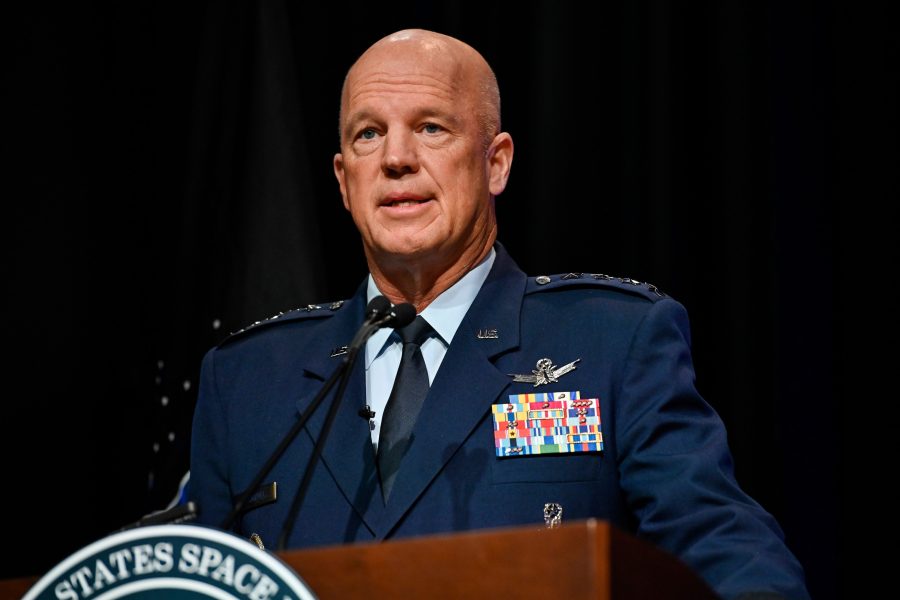New Space Force guidance directs the service to create entities like a National Space Intelligence Center, begins to set benchmarks for improving the force, and offers insight into future operations.
Chief of Space Operations Gen. John W. “Jay” Raymond rolled out the planning document Nov. 9 to communicate “my intent and [define] the capabilities and culture the USSF will pursue over my tenure,” he wrote. It also elaborates on priorities that military leaders have touted over the course of the Space Force’s first year, like speed, flexibility, technological savvy, and international cooperation.
While the guidance reads much like the Space Force’s first doctrine document that was released in August, it includes several notable updates about how the young service will proceed.
For one, Raymond wants to move parts of the National Air and Space Intelligence Center to create a co-located National Space Intelligence Center at Wright-Patterson Air Force Base, Ohio. Military officials and experts have floated that possibility over the past year as the Pentagon grapples with improving intelligence collection in space.
“In concert with the Space Force [intelligence, surveillance, and reconnaissance] enterprise, the NSIC will provide a framework for growth to meet anticipated demand for increased space intelligence at foundational, tactical, operational, and strategic levels,” the guidance said. That ISR enterprise will be spearheaded by the senior intel officer in Space Force headquarters’ operations office.
The service did not immediately answer whether NASIC, which dates back to 1961, would revert to being the National Air Intelligence Center. It’s unclear how soon the NSIC will stand up.
A top military space official said last year the Department of the Air Force needed to have a better understanding of what people, processes, and capabilities would provide comprehensive information on what’s happening in space. The push for more space intelligence support comes as the Space Force is maturing its ties with other agencies that handle the same mission, like the Defense Intelligence Agency, National Geospatial-Intelligence Agency, National Reconnaissance Office, and National Security Agency.
The Space Force also wants to create a Space Warfighting Analysis Center to “develop future force structures that meet evolving mission requirements, are resilient to the threat, and are cost-informed,” the document said. Much like the Air Force Warfighting Integration Capability group, the SWAC will hold wargames that shape those plans to benefit the joint force.
Officials at Space Force HQ are getting new marching orders as well. The headquarters includes offices to manage human capital, operations, strategy and resources, and technology and innovation, plus a staff director. In the next year, the staff director will set standards for how the Space Force approaches “structured, data-driven decision-making,” Raymond said.
The Technology and Innovation Office will also look for ways automate and digitize daily work so Space Force members can spend 15 percent more time on advanced training.
Raymond’s guidance pushes forward some of the same practices the Air Force has adopted in recent years. He expects subordinates to act on their own authority unless a superior officer specifically needs to make the call. In preparation for a world where artificial intelligence and machine learning increasingly power military software, Raymond also wants commanders to create operational plans that either people or machines can carry out.
Those plans will help warfighters and computers decide when a human should be in charge of a decision, and what tasks software can carry out on its own.
“Commanders at all levels must ensure crew commanders and mission directors are proficient at applying warfighting concepts like acceptable level of risk, self-defense, risk to mission, and risk to force, and prepared to make sound tactical decisions in a contingency,” the guidance said. “We will recognize and reward expert system management and prudent risk acceptance to meet commander’s intent.”
The document notes that the Space Force should be less vulnerable to a “first-mover” attack, or a surprise maneuver in orbit that could spur the United States to escalate into a larger conflict.
“Adversaries will target vulnerable segments to degrade the larger architecture,” Raymond added of satellites, ground controls, and other parts of the space combat enterprise. “We must ensure joint commanders are prepared to defend critical space assets that enable joint forces.”
He also noted that he’s willing to pursue more resilient, defensible systems sooner, at the risk of the Space Force’s current inventory. That could mean stopping a development or procurement program before new technologies are ready, even if it limits military operations in the short term.
Raymond told reporters Nov. 9 he expects an implementation plan with timelines and other specifics will be out in December.
